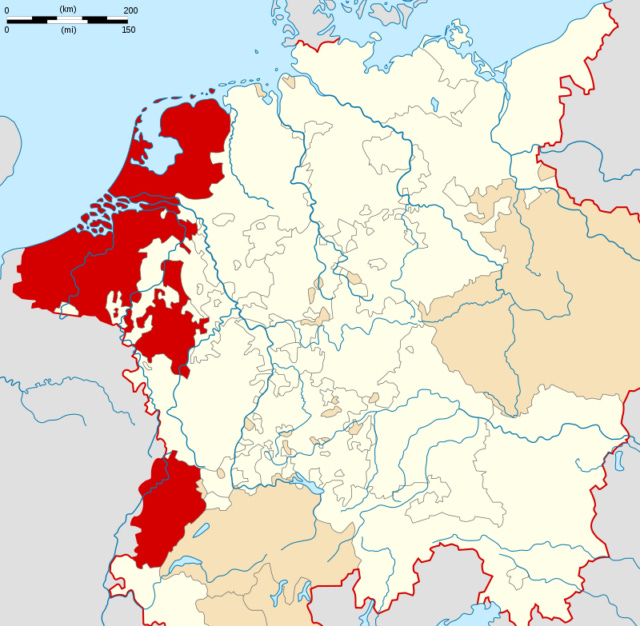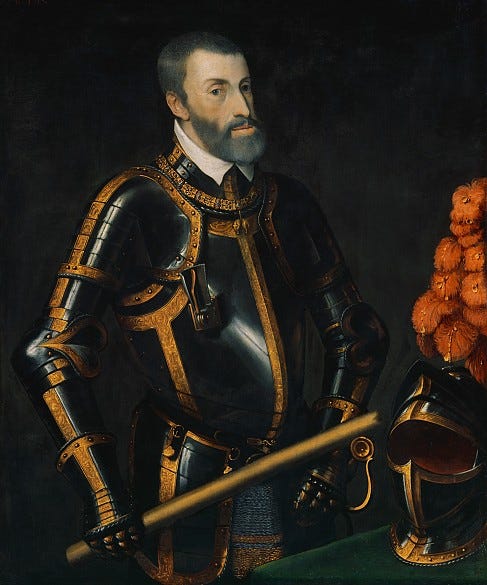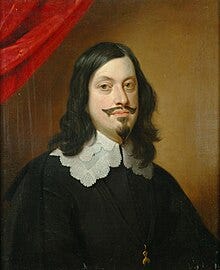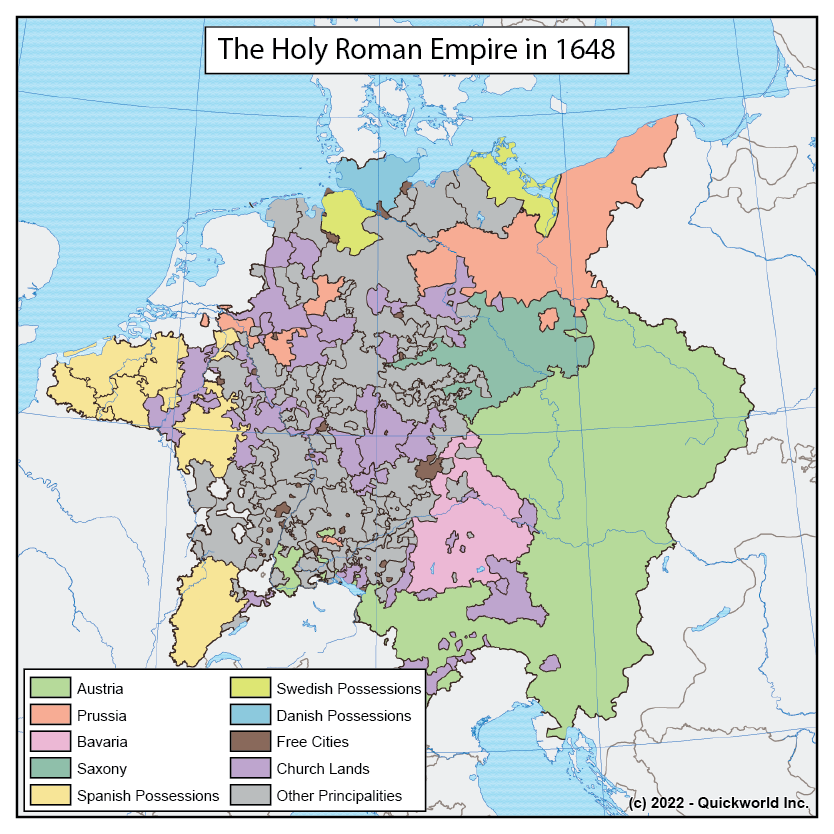With the Hapsburgs establishing themselves as a major family in Europe, they would enter an age of prosperity as the dynasty acquired many territories from strategic marriages. The Hapsburgs would rule this 16th century, so historians would consider this Golden Age for the Hapsburg family as the “Hapsburg Century.” The Habsburg dynasty, a prominent European royal house, wielded unprecedented influence during this era, shaping European history. The Habsburg Golden Age represents a period of flourishing across various domains, characterized by the expansive territorial reach of the Habsburg monarchy, the patronage of arts and sciences, and economic advancements that laid the foundation for future prosperity.
We left off in the Rise of the Hapsburgs, which you can read here, on the coronation of the first Hapsburg Holy Roman Emperor, Fredrick III.
Mary of Burgundy, sole heir to the rich Burgundian kingdom, after the death of her father, Charles the Bold, soon made her choice among the many suitors for her hand by selecting Archduke Maximilian of Austria, the future Holy Roman Emperor Maximilian I, son of Frederick III, who became her co-ruler. With the inheritance of Burgundy, the House of Habsburg began to rise to predominance in Europe. This gave rise to the saying, "Let others wage wars, but you, happy Austria, shall marry,” which became a motto of the dynasty.
The red-shaded areas represent the territories of Burgundy that were inherited by the Hapsburgs.
Frederick secured in 1486 the succession of his son in his lifetime. On 16 February 1486, Maximilian was unanimously elected Roman-German king at the Frankfurt Reichstag by the six electors present. The Elector of Bohemia was not invited because the Hungarian King Corvinus might have claimed the Bohemian spa law. There are still discussions regarding whether Frederick actively provided the initiative for his son's election or not. As Frederick's only surviving male heir though, Maximilian was a natural choice for Frederick and the Estates to counter Hungary's ambitions. On the occasion of the election of Maximilian, a ten-year land peace was decided. To safeguard the peace of the land and against the expansive territorial policy of the House of Wittelsbach, numerous affected empire-related states of Swabia joined in 1488 on Frederick's initiative for the Swabian League. After the royal election, Frederick accompanied his son to Aachen, where Maximilian was crowned on 9 April 1486. There seemed to be tensions between father and son due to differences in personalities and leadership styles. But Frederick saw Maximilian's values in negotiating with the Estates, thus even though he was wary of infringements on his imperial power, Maximilian quickly became an essential partner in imperial politics.
At the heart of the Habsburg Golden Age was a flourishing cultural patronage that elevated the dynasty to eminence in the European artistic and intellectual landscape. The reign of Emperor Maximilian I, commencing in the late 15th century, marked a significant turning point. Maximilian's court became a vibrant center of artistic innovation, attracting luminaries such as Albrecht Dürer, Hans Burgkmair, and Lucas Cranach. The Habsburgs' support for the visual arts extended beyond the court to include the commissioning of grandiose works, contributing to the Renaissance movement. In addition to visual arts, the Habsburgs played a pivotal role in fostering intellectual and scientific advancements. The court of Rudolf II, in the late 16th century, became a haven for astronomers and mathematicians, including Tycho Brahe and Johannes Kepler. This patronage significantly contributed to the Scientific Revolution, expanding our understanding of the cosmos. The Habsburgs' commitment to cultural excellence was not limited to the court. Archduke Albert VII of Austria, in the early 17th century, established the Archducal Picture Gallery in Brussels, now known as the Royal Museums of Fine Arts of Belgium. This gallery showcased a remarkable collection of masterpieces, further solidifying the Habsburgs' commitment to the arts.
Royal Museums of Fine Arts of Belgium that stands to this day.
Strategic marriages, diplomatic finesse, and military prowess characterized the political landscape of the Habsburg Golden Age. The marriage of Ferdinand II of Aragon and Isabella I of Castile in 1469 marked the union of the Spanish and Austrian branches of the Habsburgs. This matrimonial alliance laid the foundation for the Habsburgs' vast territorial dominion and political influence. Charles I of Spain and Charles V of the Holy Roman Empire would be born from this marriage. Notably, Charles would rule the vast empire of Spain as well as the Austrian territories, and in addition, he was elected Holy Roman Emperor. Charles V’s empire would be so vast that it would be considered the first time since Charlemagne that Europe was almost unified. Charles V faced significant challenges during his rule, including conflicts with the Ottoman Empire and the Protestant Reformation. In 1556, he would abdicate and split the Hapsburg family into two branches: the Austrian branch and the Spanish branch. The Austrian possessions within the Holy Roman Empire would be ruled over by his brother, Ferdinand I, while Spain alongside its colonial possessions, the Benelux, Milan, and Naples would be given to his son, Philip II.
Map of the Hapsburg Empire under the rule of Charles V before his abdication.
Charles V of the Spanish Empire or Charles I of the Holy Roman Empire.
The Empire of Charles V divided. Note the blue-shaded territories being passed to Ferdinand and the orange shades being passed to Philip. The yellow territories are the multitude of states within the Holy Roman Empire.
The Habsburgs were skilled at navigating the complex web of European politics through strategic marriages, forming alliances, and expanding their reach and influence. For instance, the marriage of Mary I of England to Philip II of Spain, son of Charles V, in 1554 aimed to create a strong Catholic alliance as a response to the Protestant Reformation. However, the alliance didn't last long, and Mary's death without an heir was a setback for Habsburg's ambitions in England. Additionally, military triumphs helped cement Habsburg's power. The Battle of Lepanto in 1571, where the Holy League, led by Philip II, defeated the Ottoman Empire, demonstrated Habsburg's military might and secured their dominance in the Mediterranean. Despite their vast empire, the Thirty Years' War (1618-1648) was a testament to the challenges faced by the Habsburgs in maintaining their power. The war, triggered by religious conflicts, resulted in significant territorial losses for the dynasty. Nevertheless, the Peace of Westphalia in 1648, which marked a decline in Habsburg power, also established a new balance of power in Europe that would shape the following centuries. At the beginning of the last decade of the Thirty Years War, Ferdinand became the king. He wanted to end the war quickly, so he introduced lenient policies that departed from the old ideas of divine right to rule, which his father Ferdinand II had followed. However, the numerous battles failed to contain the empire's Protestant enemies, and Imperial power began to decay. So, Ferdinand had to abandon the political stances of his Hapsburg predecessors to open the long road towards a peace treaty. Although his authority among the princes was weakened after the war in Bohemia, Hungary, and Austria, Ferdinand's position as sovereign was uncontested.
Portrait of Ferdinand III, Holy Roman Emperor at the conclusion of the Thirty Years War.
The Habsburg Golden Age was marked by a flourishing economy that was sustained by smart economic policies, strategic trade, and the exploitation of their vast empire's resources. The Spanish branch of the Habsburgs, in particular, benefited greatly from the influx of silver and gold from the Americas. The Spanish Habsburgs' monopoly over silver significantly enhanced the dynasty's economic power, providing the necessary resources for military campaigns, cultural patronage, and infrastructure development. The dynasty promoted the growth of trade routes and economic centers, resulting in thriving commerce throughout the Habsburg territories. Under Habsburg rule, cities like Antwerp became major centers of commerce and finance, contributing greatly to the empire's economic prosperity. The Habsburgs also invested in infrastructure projects, such as enhancing transportation and trade by improving roads and waterways, to foster economic growth. Archduke Leopold Wilhelm of Austria played a significant role in these efforts during the early 17th century.
Despite the achievements of the Golden Age, the Habsburgs faced formidable challenges that precipitated their decline. The Thirty Years' War, a protracted conflict with roots in religious and political tensions, eroded the Habsburgs' territorial holdings and strained their resources. The emergence of competing powers, such as France and the Dutch Republic, further weakened the Habsburg grip on European dominance.
Religious conflicts, notably between Catholics and Protestants, also played a significant role in the decline of Habsburg influence. The Counter-Reformation efforts, while attempting to restore Catholic unity, could not fully counteract the religious fragmentation within the empire. The Peace of Westphalia in 1648, concluding the Thirty Years' War, marked a turning point in Habsburg fortunes. The treaty recognized the independence of the Dutch Republic and the Swiss Confederacy, signaling a reduction in Habsburg territorial holdings. While the Habsburgs retained their status as a major European power, the balance of power had shifted, and the empire was no longer the unchallenged force it once was.
The legacy of the Habsburg Golden Age is multifaceted, leaving an indelible mark on European history. The cultural achievements of the era, evident in the works of artists and scientists, continue to shape our understanding of the Renaissance and the Scientific Revolution. The political strategies employed by the Habsburgs, including matrimonial alliances and military prowess, set precedents for future European diplomacy. Economically, the Habsburgs laid the groundwork for a prosperous empire through strategic trade and infrastructure development. The economic hubs established during this era contributed to the growth of commerce and finance, influencing the economic trajectory of the territories under Habsburg rule.
While the decline of the Habsburgs in the later years of the Golden Age is undeniable, the dynasty's lasting impact is evident in the cultural and political landscape of Europe. The remnants of Habsburg influence can still be observed in the architectural marvels, artistic masterpieces, and diplomatic strategies that continue to define the European continent. The Golden Age of the Habsburgs, spanning the late 15th to the 17th century, represents a pinnacle of cultural, political, and economic achievement. The Habsburg dynasty's patronage of the arts, political consolidation, economic advancements, and the challenges faced during this period collectively shaped the course of European history. The legacy of the Habsburgs endures, serving as a testament to the complexities and triumphs of a dynasty that left an indelible mark on the tapestry of European civilization.











